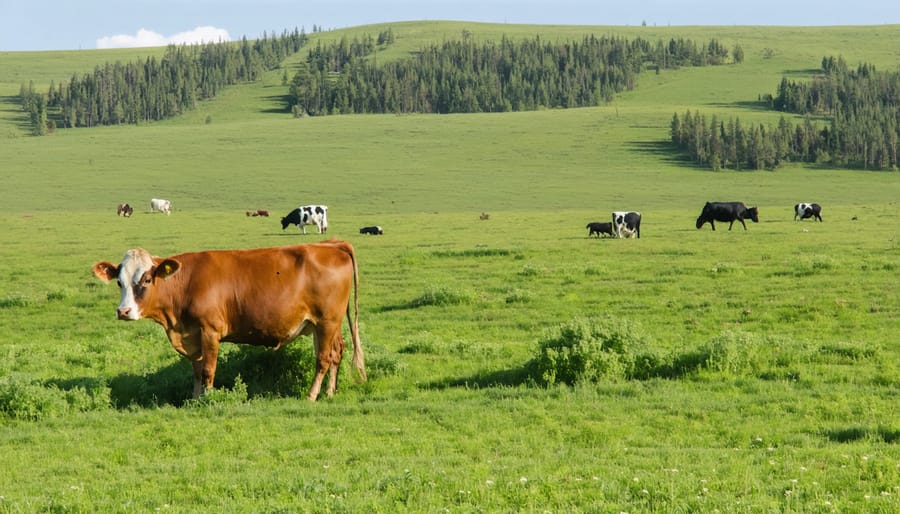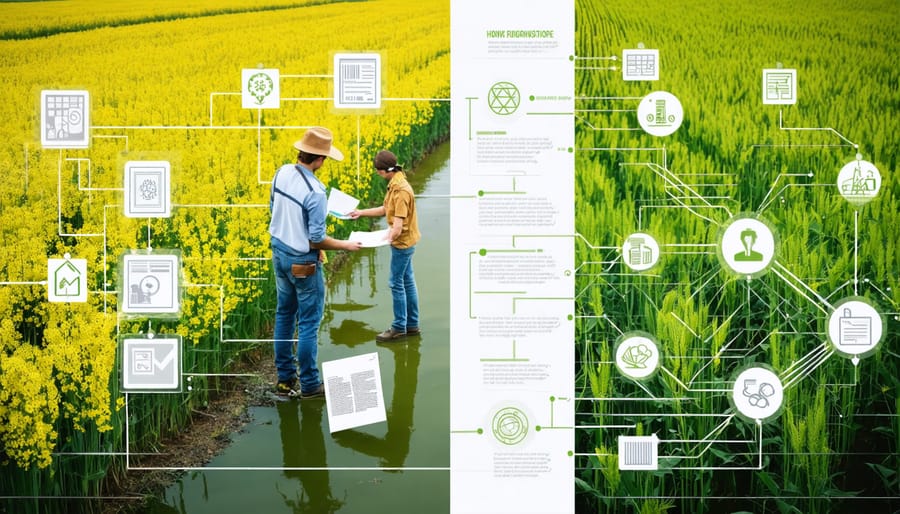What is Renewable Farming?
Soil Health
Soil health is a critical component of renewable farming. By implementing techniques such as cover cropping, crop rotation, and reduced tillage, farmers can improve soil structure, increase organic matter, and promote beneficial microbial activity. Cover crops, like legumes and grasses, protect the soil from erosion, fix nitrogen, and add biomass when incorporated into the soil. Crop rotation helps break pest and disease cycles, while also balancing nutrient demands. Minimizing tillage reduces soil disturbance, preserves moisture, and maintains soil carbon. Integrating livestock through managed grazing can also stimulate soil health by adding organic manure and encouraging plant root growth. Composting and applying organic amendments further enhance soil fertility and biodiversity. By investing in soil health, Alberta farmers can build resilient, productive land that supports sustainable yields and reduces reliance on synthetic inputs. Healthy soil is the foundation of a thriving, renewable agricultural system.
Carbon Reduction
Reducing carbon emissions is a key priority for sustainable farming practices in Alberta. One effective strategy is adopting no-till organic farming methods, which minimize soil disturbance and maintain soil structure. This approach reduces the need for fuel-intensive tillage and helps sequester carbon in the soil. Cover cropping is another powerful tool, as it adds organic matter to the soil, improves fertility, and reduces the need for synthetic inputs. Farmers can also optimize fertilizer use by conducting soil tests and applying nutrients precisely where needed. Incorporating perennial crops and agroforestry systems can further enhance carbon sequestration while providing additional benefits like wind protection and biodiversity. By implementing rotational grazing and manure management practices, livestock farmers can reduce methane emissions and improve soil health. Investing in renewable energy sources like solar panels and wind turbines can offset on-farm energy use. Through these combined strategies, Alberta farmers can significantly minimize their carbon footprint while building resilient, productive agricultural systems.
Regenerative Practices
Regenerative agriculture encompasses a variety of practices that promote soil health, biodiversity, and carbon sequestration. These regenerative practices include no-till or minimal tillage, which reduces soil disturbance and erosion. Cover cropping is another key strategy, involving planting non-cash crops to protect and enrich the soil between main crop rotations. Composting and the application of organic amendments, such as manure, help to improve soil structure and fertility. Integrating livestock through managed grazing can also contribute to soil health and carbon storage. By adopting these methods, farmers can enhance the long-term productivity and resilience of their land while minimizing environmental impacts.
Benefits for Alberta Farmers
Economic Advantages
Renewable farming practices offer significant economic advantages for Canadian farmers, particularly in terms of increased yields, reduced inputs, and access to new markets. By adopting techniques such as crop rotation, cover cropping, and precision agriculture, farmers can improve soil health and fertility, leading to higher crop yields over time. Additionally, renewable farming often requires fewer synthetic inputs like fertilizers and pesticides, which can translate to cost savings. As consumer demand for sustainably produced food grows, farmers who embrace renewable practices may find new opportunities in emerging markets for organic, regenerative, or locally sourced products. Transitioning to renewable farming can also help farmers build resilience against climate change impacts and fluctuating input costs. While the initial transition may require investment, the long-term economic benefits of renewable farming can contribute to more profitable and stable agricultural operations for Canadian farmers.

Environmental Impact
Renewable farming practices not only benefit farmers but also have a positive impact on the environment. By promoting biodiversity, these practices create a healthier ecosystem where beneficial insects, pollinators, and wildlife can thrive. This, in turn, leads to more resilient crops and reduced reliance on pesticides. Renewable farming also prioritizes water conservation through techniques like drip irrigation, mulching, and planting cover crops, which help retain moisture in the soil and prevent erosion. Moreover, by building healthy soil through practices like crop rotation, composting, and reduced tillage, farmers can enhance their land’s climate resilience. Healthy soil is better equipped to withstand extreme weather events, such as droughts or floods, and can sequester more carbon from the atmosphere. By adopting renewable practices, Alberta farmers can play a crucial role in mitigating climate change while ensuring the long-term sustainability of their farms.
Case Studies
Grain Farm
The Johnsons, a fourth-generation farming family in Camrose, Alberta, have embraced cover cropping and reduced tillage on their 2,000-acre grain farm. By planting a diverse mix of cover crops, including legumes, grasses, and brassicas, between their main cash crops, they have seen a significant improvement in soil health and fertility. The cover crops help prevent erosion, suppress weeds, and add organic matter to the soil when terminated and left as mulch.
Reducing tillage has been another key strategy for the Johnsons. They have transitioned to no-till and minimal tillage practices, which involve planting directly into the previous crop’s residue without disturbing the soil. This approach helps maintain soil structure, reduce compaction, and improve water infiltration and retention. As a result, they have observed better moisture management during dry spells and more resilient crops overall.
The Johnsons have also noted an increase in beneficial insects and soil microorganisms since adopting these practices, contributing to a more balanced and sustainable farm ecosystem. While the transition required an initial investment in specialized equipment and a learning curve, they have found that the long-term benefits, including reduced input costs and improved crop yields, have made it worthwhile. The family actively shares their experiences with other farmers in the community, encouraging them to consider cover cropping and reduced tillage as viable strategies for enhancing the sustainability and profitability of their grain farms.
Cattle Ranch
In the heart of Alberta’s ranching country, the Cattleman’s Ranch has embarked on a transformative journey towards sustainable agriculture. By adopting holistic grazing management practices, they have not only improved the health and productivity of their herd but also enhanced the resilience of their land.
The transition began with a shift in mindset, recognizing that cattle can be a powerful tool for regenerating grasslands when managed properly. The ranch implemented rotational grazing, moving the herd through a series of pastures, allowing each area to rest and recover between grazing periods. This mimics the natural movement of wild herbivores and promotes the growth of diverse, nutrient-rich forage.
The benefits have been remarkable. The cattle thrive on the varied diet, resulting in better weight gain and overall health. The soil, enriched by the concentrated manure and trampling action of the herd, has become more fertile and moisture-retentive. Native plant species, once suppressed by overgrazing, are now rebounding, creating a vibrant ecosystem that supports pollinators and wildlife.
The ranch’s success story is a testament to the power of working with nature rather than against it. By embracing holistic grazing management, they have not only bolstered their own operation but also contributed to the larger goal of building a more sustainable and resilient agricultural landscape in Alberta.
Resources and Support
Organic Farming, The Canadian Way
Organic farming is a growing movement in Canada, and Alberta is leading the way in embracing sustainable agriculture practices. By prioritizing soil health, biodiversity, and natural pest control methods, organic farmers are working to create a more resilient and environmentally-friendly food system. The Organic Transition Initiative is one example of how the province is supporting farmers in making the switch to organic practices. This program offers resources, education, and financial assistance to help farmers navigate the challenges of transitioning to organic production. As more farmers adopt these methods, they are not only improving the health of their land and crops but also contributing to a more sustainable future for Canadian agriculture. By working together and sharing knowledge, Alberta’s organic farming community is paving the way for a greener, more vibrant agricultural landscape.

Government Initiatives
The Canadian government has implemented several initiatives to support renewable farming practices. Agriculture and Agri-Food Canada (AAFC) offers funding through programs like the Agricultural Clean Technology Program, which helps farmers adopt clean technologies and reduce their environmental impact. The Living Laboratories Initiative brings together farmers, scientists, and other stakeholders to co-develop and test innovative sustainable agriculture solutions. In Alberta, the Environmental Sustainability and Climate Change Program provides grants for projects that enhance environmental stewardship, including renewable farming practices. The province also funds research and extension services through organizations like the Alberta Agriculture and Forestry and the Agriculture Financial Services Corporation. These initiatives aim to support farmers in transitioning to more sustainable practices, improving soil health, reducing greenhouse gas emissions, and enhancing biodiversity on their farms. By leveraging these resources, Alberta farmers can play a crucial role in building a more resilient and environmentally friendly agricultural sector.
Conclusion
Alberta has the potential to become a leader in renewable farming, setting an example for sustainable agriculture across Canada and beyond. By embracing regenerative practices, investing in research and innovation, and fostering a supportive community, Alberta farmers can build resilient, profitable, and environmentally friendly operations. The benefits are clear – from improved soil health and biodiversity to reduced input costs and enhanced crop yields. It’s time for Alberta farmers to take action, whether it’s starting small with cover crops or diving into a fully integrated renewable system. With the right knowledge, resources, and mindset, the future of farming in Alberta is bright, sustainable, and full of opportunity.












